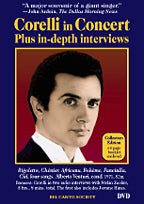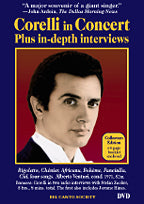1
/
of
1
Corelli in Concert
Corelli in Concert
Regular price
$13.95 USD
Regular price
$18.95 USD
Sale price
$13.95 USD
Unit price
/
per
Couldn't load pickup availability
All our DVDs are region-code 0. They play on all DVD players worldwide.
(1971). Ventura, cond. Rigoletto, Chénier, Africana, Bohème, Fanciulla, Cid + songs. 52m. Color. Collectors Edition: 32-p. booklet enclosed, includes rare photos.
DVD Bonuses: Corelli in two radio interviews with Stefan Zucker, 5 hrs., 8 mins., total. The first also includes Jerome Hines and Dodi Protero. Please click here for an audio sample from the Corelli and Jerome Hines interview. Please click here for an audio sample from the Corelli Presents Pertile interview.
If you order a total of five or more qualifying DVDs, videos, CD sets or photos at the same time, you can receive a sixth item of your choice for FREE from this list. After you have placed the required five items in your shopping cart, you can select your free item from the list that will appear at the bottom of your shopping cart page.
On this DVD Franco is very much himself. He sings to the audience as he sang to me in his living room--with the same gestures and mannerisms. And they love it! He flings himself into the encores with wild abandon. Gives spinal chills. The most personality of any Corelli DVD. Corelli's Rubato Listen to Corelli play with the tempo in Ernesto De Curtis's "Tu ca nun chiagne." He introduces ritards and accelerations. Or listen to F. Paolo Tosti's "'A Vucchella," where Corelli twice eases back into tempo after (unduly) long fermatas. Yet he told me, "I didn't do rubato for fear of being squadrato [not with the conductor's beat]." In this concert he is squadrato in "O paradiso," on the word "paradiso." The reality may have been that he was willing to sing with flexibility of tempo when with piano accompaniment, as in the De Curtis and Tosti songs, in which he sings with piano after the orchestra has left the stage. His Bobbing Larynx and Dropped Jaw Voice teacher Giovanni Battista Lamperti maintained, in Vocal Wisdom: The Maxims of Giovanni Battista Lamperti by William Earl Brown, "Though the larynx need not be held muscularly fixed in one position, for either upper or lower register, it should remain quiescent throughout a song," also that a singer should open his mouth "as wide as finger thickness." Corelli adopted an unrelated approach. In accordance with his modification of Melocchi's method, in soft passages his larynx "floated" up, in loud passages down. More, by 1971, Corelli had come to sing with his mouth wide open and jaw dropped to the maximum, on high notes, in particular--as is apparent in this concert. His Scatto At the end of "Un dì all'azzurro spazio" and the end of "Tu ca nun chiagne" Franco sings with scatto (punch), which is a reason he is so exciting.--Stefan Zucker
Booklet Table of Contents Chapter Points: Corelli in Concert Chapter Points: March 3, 1990 Interview Chapter Points: March 30, 1991 Interview Introduction to the Radio Interviews Notes to Corelli in Concert Del Monaco, Corelli and Their Influence Sweet vs. Laryngeal Tenors Corelli’s Virility Corelli’s Goal Franco Corelli: Some Missing Information Corelli’s View of the Stanley Method D100, Corelli in Concert Corelli’s Rubato His Bobbing Larynx and Dropped Jaw His Scatto Franco and Jerry Stefan Zucker PCM Audio
Chapter Points 1. Play All 52 minutes 2. Questa o quella (Rigoletto, by Giuseppe Verdi) 3. Un dì all’azzurro spazio (Andrea Chénier, by Umberto Giordano) 4. O paradiso (L’Africana, by Giacomo Meyerbeer) 5. Che gelida manina (La bohème, by Giacomo Puccini) 6. Ch’ella mi creda (La fanciulla del West, by Giacomo Puccini) 7. Ô souverain, ô juge, ô père (Le Cid, by Jules Massenet) 8. ’O sole mio (Eduardo Di Capua) 9. Core ’ngrato (Salvatore Cardillo) 10. Tu ca nun chiagne! (Ernesto De Curtis) 11. ’A Vucchella (Francesco Paolo Tosti)
Audio-only Bonuses Franco Corelli and Jerome Hines Interviewed by Stefan Zucker “Opera Fanatic,” March 3, 1990 Chapter Points 1. Play All 2 hours, 56 minutes 2. Callas vs. Olivero 3. Callas’s technique 4. Her loss of voice 5. Hines on Olivero and Callas 6. The Rome Walkout 7. Maria Caniglia 8. Beniamino Gigli 9. Has singing changed in your time? 10. Bianca Scacciati 11. Miscasting 12. Picking singers to suit operas vs. picking operas to suit singers 13. American, Italian and German styles 14. German vs. Italian legato 15. The vowel “ah” 16. The German influence 17. Renato Cellini, the first Fascist at the Met after the war 18. Cloe Elmo. Corelli favors booing 19. Booing at the Met 20. Claques 21. Booing 22. Gigli’s influence on Del Monaco 23. Big voices and 16th notes 24. Leyla Gencer 25. The Rome Walkout and the lack of covers in Italy 26. When in America Italians display temperament 27. Corelli’s favorite among his performances 28. Stanford Olsen 29. Lina Pagliughi 30. Gino Bechi, Giangiacomo Guelfi, Leonard Warren, Robert Merrill, Cornell MacNeil, Ettore Bastianini and Titta Ruffo 31. Why Corelli did not sing Ballo 32. Corelli’s favorite conductors 33. Singing too loudly 34. Grace Bumbry 35. The tempos of Karajan and Bernstein 36. A conductor Corelli did not like 37. Does Corelli approve of the Met’s casting? 38. Why the Met’s orchestra is too loud 39. The Met’s choice of singers 40. What is a Verdian voice? 41. Iodine on vocal cords 42. The Del Monaco cocktail 43. Almond oil, cortisone 44. Douglas Stanley 45. The day of a performance 46. Enzo Sordello’s herbs and the steam in his room 47. Directors’ opera 48. The biggest voices 49. Francesco Merli, Giacomo Lauri-Volpi, Birgit Nilsson, Richard Tucker, Anita Välkki, Helen Traubel, Caruso, Gino Penno 50. Sweet tenors vs. round tenors 51. A Corelli return as Otello 52. To return or not to return? 53. Nel verde maggio from Loreley, by Catalani 54. Scooping 55. Gigli’s recordings 56. Corelli’s favorite tenor 57. Ave Maria by Tortorella 58. Hines: Toscanini made us sing unnaturally 59. Corelli’s favorite soprano 60. What Corelli learned from Callas 61. What he learned from Tebaldi and Nilsson 62. Melocchi’s other students 63. Del Monaco’s influence 64. Giuseppe Di Stefano 65. The difficulty of the laryngeal method 66. The inhalation treatment that hurt Corelli’s voice 67. Why Corelli stopped his career 68. Live vs. studio recordings 69. Corelli’s films: Magnifica ossessione and La carovana nel deserto
Corelli Presents Pertile Franco Corelli Interviewed by Stefan Zucker “Opera Fanatic,” March 30, 1991 Chapter Points 1. Play All 2 hours, 12 minutes 2. Pertile’s early history 3. Lohengrin selections 4. Was Pertile a cripple? 5. Did you ever consider singing Wagner? 6. A dry voice but legato, diction, warmth and sensibility 7. Sì, pel ciel, with Benvenuto Franci, 1928 8. Bernardo De Muro 9. Ballo selections 10. The laugh in È scherzo od è follia 11. Quando le sere al placido, 1927 12. Studio vs. live recordings 13. Tosca 14. Anglo-Saxon vs. Italian taste 15. Chris Merritt and Edita Gruberova in I puritani 16. Pertile vs. Caruso 17. Corelli’s vibrato 18. Corelli’s vocal problems at the beginning of his career 19. Pertile’s vibrato vs. Giovanni Martinelli’s voce fissa 20. Chris Merritt 21. Corelli practices Puritani 22. Corelli’s high Ds in Poliuto 23. Corelli broke on an A-flat on an EMI Norma 24. Pertile’s mask placement 25. Corelli’s cancellations 26. Three arias from Manon Lescaut 27. Vesti la giubba 28. Similarities between Corelli and Pertile 29. “Loretta esci” (Loretta, get out) 30. Vieni (Denza) 1927 31. La mia sposa sarà la mia bandiera (Rotoli) 1927 32. L’ultima canzone (Tosti) 1927 33. The fight between Miguel Fleta and Pertile 34. Making allowances for false intonation 35. Apri la tua finestra, from Iris (Mascagni) 1920 36. Did Corelli’s diminuendo involve falsetto?
If you are a Corelli fan you will find this video indispensable. Many of his fans--women, in particular--say it is their favorite of all his videos. Please use this link for additional reviews of this and other Corelli titles by Richard Fawkes in Opera Now.
This DVD is the format Region 0 (all regions).
View full details
See a video clip below.
John Ardoin, reviewing in The Dallas Morning News
"Since Mr. Corelli retired from the stage, there has been no adequate Radamès, Manrico or Andrea Chénier. This recital was taped in color in 1971, with Mr. Corelli in marvelous form. A major souvenir of a giant singer."
On this DVD Franco is very much himself. He sings to the audience as he sang to me in his living room--with the same gestures and mannerisms. And they love it! He flings himself into the encores with wild abandon. Gives spinal chills. The most personality of any Corelli DVD. Corelli's Rubato Listen to Corelli play with the tempo in Ernesto De Curtis's "Tu ca nun chiagne." He introduces ritards and accelerations. Or listen to F. Paolo Tosti's "'A Vucchella," where Corelli twice eases back into tempo after (unduly) long fermatas. Yet he told me, "I didn't do rubato for fear of being squadrato [not with the conductor's beat]." In this concert he is squadrato in "O paradiso," on the word "paradiso." The reality may have been that he was willing to sing with flexibility of tempo when with piano accompaniment, as in the De Curtis and Tosti songs, in which he sings with piano after the orchestra has left the stage. His Bobbing Larynx and Dropped Jaw Voice teacher Giovanni Battista Lamperti maintained, in Vocal Wisdom: The Maxims of Giovanni Battista Lamperti by William Earl Brown, "Though the larynx need not be held muscularly fixed in one position, for either upper or lower register, it should remain quiescent throughout a song," also that a singer should open his mouth "as wide as finger thickness." Corelli adopted an unrelated approach. In accordance with his modification of Melocchi's method, in soft passages his larynx "floated" up, in loud passages down. More, by 1971, Corelli had come to sing with his mouth wide open and jaw dropped to the maximum, on high notes, in particular--as is apparent in this concert. His Scatto At the end of "Un dì all'azzurro spazio" and the end of "Tu ca nun chiagne" Franco sings with scatto (punch), which is a reason he is so exciting.--Stefan Zucker
Booklet Table of Contents Chapter Points: Corelli in Concert Chapter Points: March 3, 1990 Interview Chapter Points: March 30, 1991 Interview Introduction to the Radio Interviews Notes to Corelli in Concert Del Monaco, Corelli and Their Influence Sweet vs. Laryngeal Tenors Corelli’s Virility Corelli’s Goal Franco Corelli: Some Missing Information Corelli’s View of the Stanley Method D100, Corelli in Concert Corelli’s Rubato His Bobbing Larynx and Dropped Jaw His Scatto Franco and Jerry Stefan Zucker PCM Audio
Chapter Points 1. Play All 52 minutes 2. Questa o quella (Rigoletto, by Giuseppe Verdi) 3. Un dì all’azzurro spazio (Andrea Chénier, by Umberto Giordano) 4. O paradiso (L’Africana, by Giacomo Meyerbeer) 5. Che gelida manina (La bohème, by Giacomo Puccini) 6. Ch’ella mi creda (La fanciulla del West, by Giacomo Puccini) 7. Ô souverain, ô juge, ô père (Le Cid, by Jules Massenet) 8. ’O sole mio (Eduardo Di Capua) 9. Core ’ngrato (Salvatore Cardillo) 10. Tu ca nun chiagne! (Ernesto De Curtis) 11. ’A Vucchella (Francesco Paolo Tosti)
Audio-only Bonuses Franco Corelli and Jerome Hines Interviewed by Stefan Zucker “Opera Fanatic,” March 3, 1990 Chapter Points 1. Play All 2 hours, 56 minutes 2. Callas vs. Olivero 3. Callas’s technique 4. Her loss of voice 5. Hines on Olivero and Callas 6. The Rome Walkout 7. Maria Caniglia 8. Beniamino Gigli 9. Has singing changed in your time? 10. Bianca Scacciati 11. Miscasting 12. Picking singers to suit operas vs. picking operas to suit singers 13. American, Italian and German styles 14. German vs. Italian legato 15. The vowel “ah” 16. The German influence 17. Renato Cellini, the first Fascist at the Met after the war 18. Cloe Elmo. Corelli favors booing 19. Booing at the Met 20. Claques 21. Booing 22. Gigli’s influence on Del Monaco 23. Big voices and 16th notes 24. Leyla Gencer 25. The Rome Walkout and the lack of covers in Italy 26. When in America Italians display temperament 27. Corelli’s favorite among his performances 28. Stanford Olsen 29. Lina Pagliughi 30. Gino Bechi, Giangiacomo Guelfi, Leonard Warren, Robert Merrill, Cornell MacNeil, Ettore Bastianini and Titta Ruffo 31. Why Corelli did not sing Ballo 32. Corelli’s favorite conductors 33. Singing too loudly 34. Grace Bumbry 35. The tempos of Karajan and Bernstein 36. A conductor Corelli did not like 37. Does Corelli approve of the Met’s casting? 38. Why the Met’s orchestra is too loud 39. The Met’s choice of singers 40. What is a Verdian voice? 41. Iodine on vocal cords 42. The Del Monaco cocktail 43. Almond oil, cortisone 44. Douglas Stanley 45. The day of a performance 46. Enzo Sordello’s herbs and the steam in his room 47. Directors’ opera 48. The biggest voices 49. Francesco Merli, Giacomo Lauri-Volpi, Birgit Nilsson, Richard Tucker, Anita Välkki, Helen Traubel, Caruso, Gino Penno 50. Sweet tenors vs. round tenors 51. A Corelli return as Otello 52. To return or not to return? 53. Nel verde maggio from Loreley, by Catalani 54. Scooping 55. Gigli’s recordings 56. Corelli’s favorite tenor 57. Ave Maria by Tortorella 58. Hines: Toscanini made us sing unnaturally 59. Corelli’s favorite soprano 60. What Corelli learned from Callas 61. What he learned from Tebaldi and Nilsson 62. Melocchi’s other students 63. Del Monaco’s influence 64. Giuseppe Di Stefano 65. The difficulty of the laryngeal method 66. The inhalation treatment that hurt Corelli’s voice 67. Why Corelli stopped his career 68. Live vs. studio recordings 69. Corelli’s films: Magnifica ossessione and La carovana nel deserto
Corelli Presents Pertile Franco Corelli Interviewed by Stefan Zucker “Opera Fanatic,” March 30, 1991 Chapter Points 1. Play All 2 hours, 12 minutes 2. Pertile’s early history 3. Lohengrin selections 4. Was Pertile a cripple? 5. Did you ever consider singing Wagner? 6. A dry voice but legato, diction, warmth and sensibility 7. Sì, pel ciel, with Benvenuto Franci, 1928 8. Bernardo De Muro 9. Ballo selections 10. The laugh in È scherzo od è follia 11. Quando le sere al placido, 1927 12. Studio vs. live recordings 13. Tosca 14. Anglo-Saxon vs. Italian taste 15. Chris Merritt and Edita Gruberova in I puritani 16. Pertile vs. Caruso 17. Corelli’s vibrato 18. Corelli’s vocal problems at the beginning of his career 19. Pertile’s vibrato vs. Giovanni Martinelli’s voce fissa 20. Chris Merritt 21. Corelli practices Puritani 22. Corelli’s high Ds in Poliuto 23. Corelli broke on an A-flat on an EMI Norma 24. Pertile’s mask placement 25. Corelli’s cancellations 26. Three arias from Manon Lescaut 27. Vesti la giubba 28. Similarities between Corelli and Pertile 29. “Loretta esci” (Loretta, get out) 30. Vieni (Denza) 1927 31. La mia sposa sarà la mia bandiera (Rotoli) 1927 32. L’ultima canzone (Tosti) 1927 33. The fight between Miguel Fleta and Pertile 34. Making allowances for false intonation 35. Apri la tua finestra, from Iris (Mascagni) 1920 36. Did Corelli’s diminuendo involve falsetto?
If you are a Corelli fan you will find this video indispensable. Many of his fans--women, in particular--say it is their favorite of all his videos. Please use this link for additional reviews of this and other Corelli titles by Richard Fawkes in Opera Now.
This DVD is the format Region 0 (all regions).


